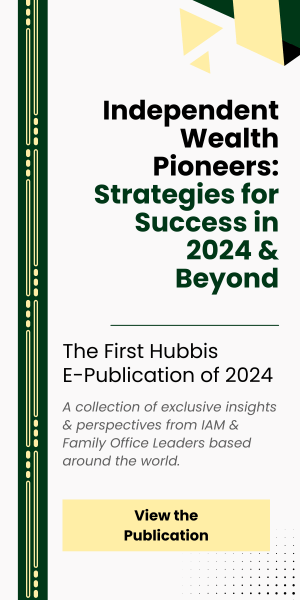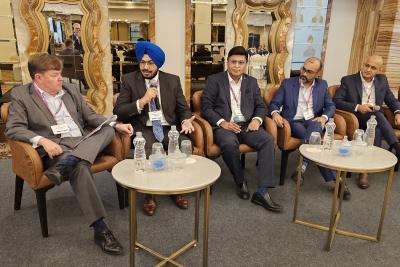Publications & Thought Leadership
Transforming and Scaling the Investment Offering

May 3, 2023
On Thursday, March 30th, Hubbis hosted a virtual discussion with the key topic of the day - transforming and scaling the investment offering. This is vitally important as the region’s wealth management community jostles for position amidst the continued growth of private wealth in Asia, as incumbents embrace the rapid democratisation of private wealth across new segments of wealth, and as they also face up to the threats of big brand institutions that are at the forefront of intensifying competition, including from new entrants who are agile and are targeting a variety of wealth management market niches in the region.
Sponsor: additiv
The Panel of Experts:
- Avishek Nandy, Partner, Bain & Company
- Adeline Tan, Partner, Wealth Business Leader, Mercer
- Catalin Burlacu, Portfolio Manager, Managing Director, New Dimensions Capital
- Dhruv Arora, Founder, CEO, Syfe
- Anurag Pandey, Head of Platform and Partnerships (APAC), additiv
These are some of the questions the panel addressed:
- What are the key trends in the curation and delivery of the investment proposition amongst private banks and other key players in Asia?
- How can the new wealth model align both the human and digital in a seamless collaboration for the delivery of optimised investment products, ideas and advice for private wealth clients?
- Why should you work with the external digital investment platforms, what do they offer and what innovations lie ahead?
- What is coming next in the world of digital technologies and services that will further enhance the wealth management offering in the region?
- How do you achieve investment and advisory personalisation and hyper-personalisation at scale?
- How can digital solutions and/or external platforms help to elevate the skills, capabilities and productivity of the RMs and advisors who are promoting investment ideas and advice?
- What about the vital role of data management and analytics and the application of AI and Machine Learning in the investment curation process?
- What role does CLM/CRM play in helping to deliver personalisation, relevance, suitability and client loyalty?
- Buy, build or outsource, what is the best approach to elevating and scaling the investment proposition?
- What's coming next and are we prepared?
Setting the Scene
The rapid expansion of the mass affluent market segment in Asia means wealth managers and private banks are keen to ‘democratise’ their services and their investment offerings across a wider audience of clients. Delivery of relevant, personalised, and timely investment products and associated advisory suite is essential.
In Asia’s dynamic wealth management markets, this drive to personalisation of the investment offering has a relatively young, tech-savvy and rapidly expanding mass affluent market that is increasingly drawn to the world of investments, but who want a seamless, interactive, and tailored offering that is highly relevant to their lifestyles, their needs and their aspirations for the decades ahead, and importantly, deliverable online or mobile.
Moreover, clients in the HNW segment (itself also projected to continue its rapid expansion) are also wanting the optionality of self-directed investing supported by the hybrid wealth management proposition combining the best of digital tools and RM support & advisory.
To achieve these goals, the application of well-formulated, forward-thinking management strategies and the selection of the best digital solutions are required, as new and smarter approaches, and better technology revolutionise the offerings and efficiencies of private wealth managers and the broader wealth management community in the region.
And of course, external digital/electronic investment platforms, replete with their expanding and highly cost-effective smorgasbord of offerings across the wealth spectrum, are an essential part of the evolution.
The hand-selected Hubbis panel of experts analysed where technology solutions and investment platforms can help the banks and other players improve their investment offerings, not only in terms of the product suite, but also the delivery of RM-led communication, advisory and also discretionary portfolio management (DPM), and the overall user experience.
They helped identify the right strategies and discuss what the next suite of solutions might be. They debated whether technology investment is being properly targeted and executed, and discussed how the wealth management organisations competing in the Asia region can best adopt, and also assimilate these new technologies to enhance their investment propositions.
Most importantly, the panel looked at the great advantages and opportunities for those who get this right and the risks for those who fail to take the right steps or who misdirect their management approach or their technology investments, or both.
The Hubbis Post-Event Survey
How well is the wealth management industry in Asia investing in and adopting the right technology solutions to boost investment solutions and client engagement?
Incredible progress in recent years 8%
Some advance, much more to do 90%
No noticeable change 2%
In general, how good are Asia’s private banks and wealth management firms at truly understanding and engaging with their private clients?
Incredibly good 10%
Quite good, improving 60%
Average 25%
Nowhere near as good as they should be 5%
To what extent do you think AI, ML, and data analytics can truly boost the curation of investment ideas and robust portfolios for Asia’s private clients?
Dramatically 30%
Marginally 65%
Not greatly 5%
Where is the Robo Advisory offering most relevant and effective for the Asian WM industry?
Mass Affluent 61%
HNW 20%
Retail 17%
UHNW 2%
Where should the Asian wealth industry should focus its next major digitisation investment and effort?
Front-end/RM/advisor 40%
Mid-Office 40%
Back-office 20%
In the drive to enhance investment solutions with digital tools, do you think enhanced technology capabilities and upgrades should be built in-house or outsourced?
Built in-house 15%
Outsourced 17%
Combination of both approaches 68%
How would you characterise the wealth management industry in Asia in its investment proposition compared with the top global wealth management centres in the US or Europe?
Absolutely on a level with the best quality offerings around the world 20%
Improved but still some way to go to match the best on offer globally 75%
Significantly behind in many areas and playing catch-up 5
Which types of wealth management competitors are best at delivering digitally enhanced investment solutions and engagement with private clients in Asia?
Global private banks 33%
Robo advisory platforms 24%
Boutique international private banks 19%
Independent wealth management firms 14%
Regional private banks 10%
“If you look at different parts of the ecosystem, they have grown at different paces,” an expert opined. “There are some banks who are now digitally savvy, but still, when you compare it against the new age wealth managers offering robots and others there is still a massive differentiation in terms of the experience that a client has. What that means is the technology has evolved, people have used technology, people have started scaling up investment offerings, but there is still a massive challenge as far as the entire value chain is concerned.”
He said the banks and others might have become better at user experience on one side, but are still lagging quite a fair bit as far as the operational efficiency is concerned, which means that some of the offerings are only viable for high net worth or ultra high net worth individuals. Whereas using technology, those same opportunities should be available for high net worth clients or even retail clients.
“There is a very big opportunity in Asia, with an estimated USD4.7 trillion potentially available for wealth management cross the board,” said another guest. “But there are some gaps to cover for the digital platform proposition. For example, how do you really evaluate suitability. We all know, if you go to digital advisors, you get seven to 10 questions and you end up set in the risk profile of their choice. But it has to also be more behavioural, we have to understand more about the client, use more data and then monitor.”
Key Insights & Observations
At times of trouble in global financial markets, stresses can be relieved with optimised client service
In bullish times, wealth management providers struggle to really drive home their service differentiation proposition, because clients are all focused on piling into the markets, and rising tides are floating all the boats. But those times are gone for now.
A guest highlighted how there are more portfolios suffering a wider range of situations that have impaired them, or that might hit performance than in the past several recent years, hence there is greater value and demand for a platform that offers investor clients a genuine ‘what-if’ capability to project through the portfolio under different stress scenarios.
“I think this kind of add-on service has really helped some clients feel that actually a portfolio approach is the best way to approach diversification and gives them the best way to think about managing costs and is also the best way to actually invest in a long-term sustainable manner,” she said.
She added that in the wealth industry, the differentiation aspect amongst all the wealth managers today is really centred around client service, the part that you can’t quite easily automate and the part that you cannot easily scale.
“Through support from AI-related tools, and through appropriate training, it is possible to elevate the client service to the point where the client raves about that service. Yes, investment performance is important, but the service element is key and the approach to how their portfolios are monitored is very important.”
Suitability and relevance are all well and good, but the regulators must not be overly protective of investors, and appreciate that there is no reward without elements of risk
Is investing in the financial markets risk free? No, of course not, but there is criticism levels at regulators in some markets, for example Hong Kong, the whole suitability framework and suitability design err too far to what the regulator perceives as protecting investors.
“They do not want investors to lose money, which is right, but after all, this is investing, and that means both risk and reward, said one guest. “In some cases, you might take a lot more risk and get little reward or take little risk and get larger rewards. In short, the wealth managers in Hong Kong can become somewhat frustrated, especially for example if they are a regional bank, and they have large client base in Singapore where MAS takes a lot more flexible view.”
She added that specific examples are the Greater Bay Area and Wealth Management Connect initiatives. “There was such excitement over WMC early on,” she said, “and then they found you can only sell a certain tier product which frankly, if I was a high-net-worth investor, I can get already. Why would I need the WMC to access that? I want to actually access products that are not available locally, that are new to me.”
She noted that the sort of messages coming down from the C-suite at the banks is the greater need from the regulators to support the growth of wealth management as an industry in Hong Kong.
“When it trickles down to the individual case officers that come down, knock on your door, sit down and want to see all the paperwork on all your clients, somehow that message gets lost,” she observed. “The mindset becomes more about mining out any and all the mistakes that these banks or others have made, rather than having a discussion and understanding more about your business, and what your business needs to thrive.”
But this same expert said she is not sure this will improve anytime soon. “Maybe the regulators have discussions around opening up some more to attract especially mainland Chinese investors locally. And more conversations about suitability. But maybe finally there will be a comfortable framework that everybody can execute and work with.”
“I am hopeful that regulators can find more of a middle ground to actually align the suitability framework to a more holistic way of looking at things as the public actually is getting more and more sophisticated, buying a lot more upside Hang Seng Index tracker funds, and doing more interesting things,” she concluded. “The public in general is getting more aware and more sophisticated, and the regulator probably needs to catch up with it,” she stated.
Differentiation is vital and easier to provide in tougher markets, when clients expect banks and wealth firms to go that extra mile
A panellist added his take around differentiation, noting that differentiation cannot just be on the products and propositions. “It is the overall holistic services that you bring to the clients and banks that help achieve that, whether it's the value-added services, whether it's credit, or whether it is all of these things together in the service, combined with the digital experience, I think that is what really moves the needle.”
He then addressed the question of how in practice a wealth manager will set about the challenge and the process of scaling and improving its investment offering. “The focus has to be a starting point around the advisory-led approach,” he advised. “Clients need to feel that you are bringing structured advice, leveraging your insights and your tools in order to make those types of recommendations, versus coming with an underlying sort of mandate of pushing a particular product, which is a criticism we hear from the client side regularly.”
He added that the challenge is to put that advisory-led approach in the right sort of value chain and that requires the right technology to enable that. “There are many house views and portfolio recommendations, but there is all too often a clear gap between what the head office or the CIO office is thinking compared to the insights and messages actually being delivered to the client.” Technology in the form of the right digital solutions and protocols can help bridge that gap.
He said when clients are being literally bombarded with numerous insights and lots of news on specific asset classes but wondered why the ‘so what?’ or next steps or advised actions are too often lacking.
Advisory-led insights
“How do you link those insights to actions?” he pondered. How do you talk to clients at the right time when they are probably the most anxious about market volatility and other events? And how do you take that sort of advisory-led approach across the value chain, whether it is initial portfolio construction, and the advisory or through to the ongoing engagement. These are areas that banks need to do a lot better.”
To go that extra mile, you need to be able to free RMs, and empower advisors
A guest explained that many banks and wealth firms are running hard to be able to scale up their investment offerings.
“There are, as we all know, supply constraints in terms of the RMs and that affects banks’ ability to scale up the business, both in terms of client acquisition, and deepening the share of wallet with existing clients, both of which are vital objectives,” he noted. “The growth that we see in terms of AUM or the market itself versus the supply growth, from an RM standpoint, or individual capability standpoint, means there is a significant gap to be bridged. This is probably one of the key issues that most wealth managers and private banks are grappling with.”
Real hopes for AI
A guest turned his gaze on the evolution of AI, which he said is essentially at an inflection point. He said Bain & Co had entered a partnership with open AI on this topic, and they are having active conversations with clients. “The use case in wealth is definitely very promising, especially around RM/advisor empowerment and enablement, although perhaps less so on the direct to client enablement,” he commented.
He said, for example there are valuable AI use cases around preparing for client meetings, taking numerous sources of information that the RMs are bombarded with, synthesising it all and thinking about how then to convert that to the right type of ‘pitch’ to the client that will engage them and that has a significant impact.
He said, for example, there could be voice to text conversion and summary of the calls with clients that becomes essentially a summary like meeting minutes, and then extrapolate those into actions, into email drafts and so forth. “There are some very interesting productivity use cases that can really drive a lot of value in the near term,” he remarked. “It is clearly a promising area, especially for the human assisted model, and how AI can play a role in that.”
Far more to come
On top of that, more advanced AI capabilities centre on working with analytics engines or next-best-product offers, and making all that more sophisticated, but that is further down the road.
“Clearly, AI is not being used to full potential yet, but given the technology evolution and the pace at which it is developing, we do see that inflection point coming where this is going to be really picking up,” he explained. “However, the main concern that remains is how this all fits into the technology architecture and the security issues, the reliability of AI; I think those are things definitely top of mind for clients.”
He then turned his attention to closing remarks on designing the digital-first investment platform, or conceptualising it, noting that the education feature is coming out as one of the key aspects that the clients are looking at, according to Bain’s own research.
Are you hitting your targets?
He added that while everyone is talking about technology, they have invested heavily in technology, the big question is whether that technology is providing or delivering on the business case it was designed to deliver in terms of productivity outcomes, or additional benefits for clients.
“The centre of gravity needs to move from the back-end products, fusion engines to a lot more focus on what needs to happen in the front and the middle,” he explained. “We see still too much of a silo approach, for example banks where they have implemented digital like features, but those do not then integrate well with everything else that the bank does or integrate well with the RMs or the frontline. You really need to connect the dots across all of these things.”
“In Singapore, the regulator maybe does not have a long track record, but is quite advanced in advising in such a way digital platforms, banks, private banks, as well, in which they have to make sure clients understand the risks they are taking. They have to understand the clients are able to take risk, not only desiring to take a certain risk. So, the nuance here is we cannot have riskless investments, as a colleague on the panel said. In this business, there is no risk-less investment; if there was there would be no need for any of us! Our job is to make sure clients are understanding and aware of these risks.”
AI can significantly help with distilling vast amounts of data and information, so we can more easily deliver something manageable for clients. But my background is quant investor, is the screening part, so I need to do much more than screening to analyse a reason to invest in a stock or in a portfolio in a set of stocks. We need a bit more from AI and machine learning from a risk management perspective, a bit more filtering, probably a bit more value put into screening out some of the factors or ideas that actually don't work.”








